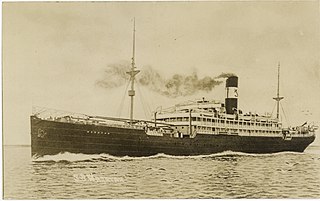
USS Santiago de Cuba was a side-wheel steamship acquired by the Union Navy during the first year of the American Civil War. She was outfitted as a gunboat with powerful 20-pounder rifled guns and 32-pounder cannon and was assigned to the Union blockade of the Confederate States of America. She was notably successful in this role, capturing several blockade runners. Her last major action of the war was the assault on Fort Fisher, during which seven of her crew won the Medal of Honor.

Sir Donald Currie was a Scottish shipowner, politician and philanthropist.

Braamfontein is a central suburb of Johannesburg, in South Africa, seat of the Constitutional Court of South Africa and some of South Africa's major corporations such as Liberty Holdings Limited, JD Group, Sappi, Bidvest Bank and Hollard. Situated due north of the city centre, Braamfontein is the fourth-largest office node in the city of Johannesburg containing many multi-storied buildings representing various architectural styles including Art Deco and Brutalist. Numerous office buildings have and are in the process of being converted to residential apartments. The offices of the Johannesburg City Council and the University of the Witwatersrand are situated in Braamfontein. The Nelson Mandela Bridge is a landmark that connects Braamfontein to the city centre, traversing South Africa's most extensive passenger train marshalling yard. Jan Smuts Avenue and Empire Road are two major road thoroughfares that run through the suburb.

SS Waratah was a passenger and cargo steamship built in 1908 for the Blue Anchor Line to operate between Europe and Australia. In July 1909, on only her second voyage, the ship, en route along the coast of the Colony of Natal from Durban to Cape Town, disappeared with 211 passengers and crew aboard. No trace of the ship has ever been found.

The Colony of Natal was a British colony in south-eastern Africa. It was proclaimed a British colony on 4 May 1843 after the British government had annexed the Boer Republic of Natalia, and on 31 May 1910 combined with three other colonies to form the Union of South Africa, as one of its provinces. It is now the KwaZulu-Natal province of South Africa.

Edward Knight Collins I was an American shipping magnate.

George Thompson of Pitmedden (1804–1895) was a Scottish Liberal politician who was The Lord Provost of Aberdeen and MP for city. He was also the founder of the Aberdeen Line shipping company.
The General Screw Steam Shipping Company was a British company established in 1848 by James Laming, who had for about 30 years owned sailing ships travelling between England and the Netherlands.
Begha is a village south of East London in South Africa at the mouth of the Birha River.

The Madagascar was a ship of the Rennie line that was lost in 1858 after she hit a reef near the mouth of the Birha River, south of East London, in South Africa, around midnight on 3 December. Attempts to keep the ship afloat failed and she was run aground on the 4th and broke up. No lives were lost.
The Waldensian was a steamship of the Rennie line that was lost on 13 October 1862, after it ran aground on rocks at Struis Point near Cape Agulhas en route from Durban to Cape Town. The passengers included eight predikants of the Dutch Reformed Church, one of them, the reverend Frans L. Cachet, later writing that it was said on leaving Durban that the ship would not arrive safely, as "one minister aboard a ship is bad enough, but with eight on board, things could not possibly go well." There was no loss of life.

The Umgeni was a sailing ship of the Rennie line. She was launched in 1864 and served as a passenger ship transporting colonists to Natal before being converted to a coal carrier. In 1876 she ran aground near Glenelg in South Australia but was re-floated.
The Transvaal was a wooden barque cargo ship of the Rennie line. In December 1874 on her maiden voyage from London she dragged anchor and was driven ashore south of the Umgeni River in South Africa, causing 12 deaths.
Anglo-African was a steam cargo ship built in 1900 by the Short Brothers of Sunderland for Lawther, Latta & Co. of London with intention of operating on their Australian routes. The vessel operated mostly on South America to North America route during her career and was wrecked on one of her regular voyages in January 1909.
Charkieh was an iron screw steamer launched in 1865. Built at Leamouth near London, she was purchased by the Khedivate of Egypt as a mail steamer. She was in a collision in the River Thames in 1872 and was eventually wrecked off Greece in 1900.
The Far Eastern Freight Conference was a co-operative agreement between a group of steamship owners and shipbrokers involved in scheduled cargo liner services principally between China and Japan, and European ports. It was established in 1879 as the China and Japan Conference through the efforts of John Swire. They co-operated in order to overcome excess capacity of steamers in that trade. Described by some as a cartel, the conference rewarded shippers that gave all their business to ships owned by conference members through a system of deferred rebates to the freight rates charged. These discounts were deferred for, typically, six months and were not payable if the shipper used a ship outside the conference in that time. Capacity was controlled by limiting each member to an agreed number of sailings during the year. The conference survived a legal challenge in 1885, which went to the High Court in 1887, then through the Court of Appeal and ultimately to the House of Lords: the conference won at every level. There were later challenges and enquiries, which the conference survived. Ultimately, changes to the European Union exemption of shipping conferences from their competition regulations brought the conference to an end in October 2008.












